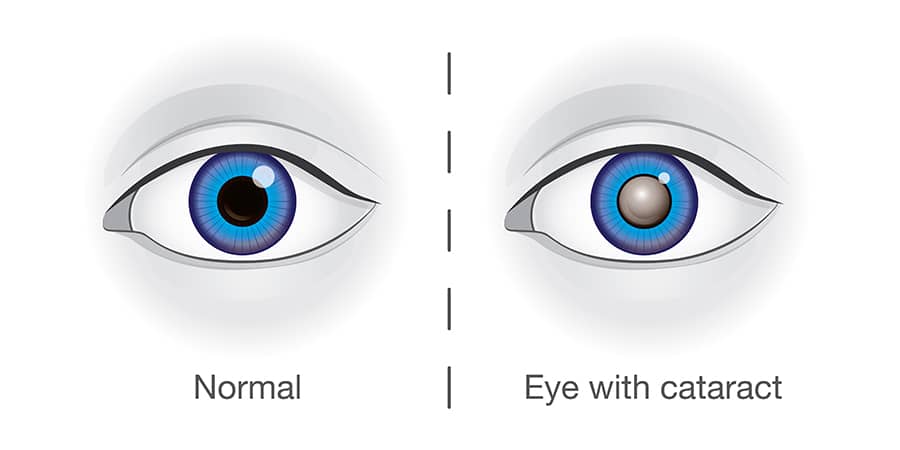A cataract is a dense, cloudy area that forms in the lens of the eye. For people who have cataracts, seeing through cloudy lenses is a bit like looking through a frosty or fogged-up window. A cataract begins when proteins in the eye form clumps that prevent the lens from sending clear images to the retina. Clouded vision caused by cataracts can make it more difficult to read, drive a car (especially at night) or see the expression on a friend’s face. Most cataracts develop slowly and don’t disturb your eyesight early on. But with time, cataracts will eventually interfere with your vision. At first, stronger lighting and eyeglasses can help you deal with cataracts. But if impaired vision interferes with your usual activities, you might need cataract surgery. Fortunately, cataract surgery is generally a safe, effective procedure.
How a cataract forms
A cataract is a cloudy lens. The lens is positioned behind the colored part of your eye (iris). The lens focuses light that passes into your eye, producing clear, sharp images on the retina — the light-sensitive membrane in the eye that functions like the film in a camera.
Symptoms of Cataracts
Common symptoms of cataracts include:
- blurry vision
- trouble seeing at night
- seeing colors as faded
- increased sensitivity to glare
- halos surrounding lights
- double vision in the affected eye
- a need for frequent changes in prescription glasses
What Causes Cataracts?
There are several underlying causes of cataracts. These include:
- an overproduction of oxidants, which are oxygen molecules that have been chemically altered due to normal daily life
- smoking
- ultraviolet radiation
- the long-term use of steroids and other medications
- certain diseases, such as diabetes
- trauma
- radiation therapy
Types of Cataracts
There are different types of cataracts. They’re classified based on where and how they develop in your eye.
- Nuclear cataracts form in the middle of the lens and cause the nucleus, or the center, to become yellow or brown.
- Cortical cataracts are wedge-shaped and form around the edges of the nucleus.
- Posterior capsular cataracts form faster than the other two types and affect the back of the lens.
- Congenital cataracts, which are present at birth or form during a baby’s first year, are less common than age-related cataracts.
- Secondary cataracts are caused by disease or medications. Diseases that are linked with the development of cataracts include glaucoma and diabetes. The use of the steroid prednisone and other medications can sometimes lead to cataracts.
- Traumatic cataracts develop after an injury to the eye, but it can take several years for this to happen.
- Radiation cataracts can form after a person undergoes radiation treatment for cancer.
Risk Factors of Cataracts
Risk factors associated with cataracts include:
- older age
- heavy alcohol use
- smoking
- obesity
- high blood pressure
- previous eye injuries
- a family history of cataracts
- too much sun exposure
- diabetes
- exposure to radiation from X-rays and cancer treatments
How to prevent Cataracts
To reduce your risk of developing cataracts:
- protect your eyes from UVB rays by wearing sunglasses outside
- have regular eye exams
- stop smoking
- eat fruits and vegetables that contain antioxidants
- maintain a healthy weight
- keep diabetes and other medical conditions in check
Treatment of Cataracts
Surgery is recommended when cataracts prevent you from going about your daily activities, such as reading or driving. It’s also performed when cataracts interfere with the treatment of other eye problems.
One surgical method, known as phacoemulsification, involves the use of ultrasound waves to break the lens apart and remove the pieces. But If you’re unable or uninterested in surgery, your doctor may be able to help you manage your symptoms. They may suggest stronger eyeglasses, magnifying lenses, or sunglasses with an anti-glare coating. Surgery to remove a cataract is generally very safe and has a high success rate.
